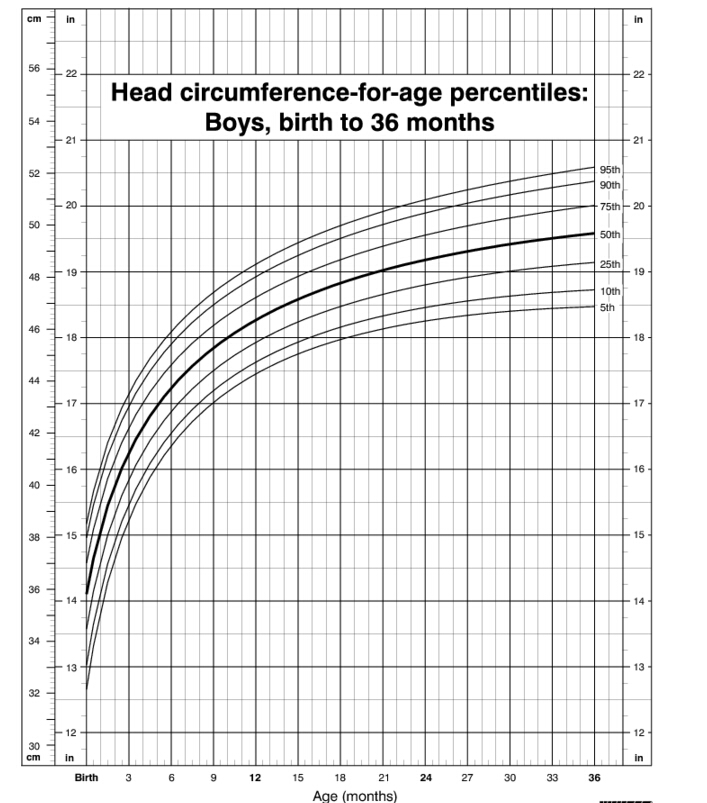Newborn babies come with a lot of questions and no instruction manual to follow. There are numerous baby books out there, but not many contain a good head circumference chart to check your baby’s head size. If your pediatrician takes your baby’s head measurements at each visit, you just might want to know why they do that?
How Is Head Circumference Measured?

When you take your baby to the pediatrician, either the nurse or the doctor will use a soft tape measure around your baby’s head. Your baby may cry because of cold hands or anxiety with strangers touching him or her, but it is not painful in any way. They will do this quickly and get a measurement of how big the head is. It is done on newborns up to the age of 2 years old. The fontanels on your baby’s head will close up when they are approximately 18 months old and the period of rapid brain growth slows down, so there will be less need to measure.
Why Measure It?
The head circumference is measured to check brain growth and development of your baby. It is measured in centimeters and compared to a head circumference chart. The chart is kept in your baby’s medical file so the doctor can see:
- The size your baby’s head measured at the last visits
- The national average for babies at this size, gender, and age
Your baby’s doctor will be able to tell there may be a problem with brain development if:
- The head growth seems faster or slower than normal
- There is an odd shape to the head
- The baby’s head circumference doesn’t measure up to the percentile for height and weight
Head Circumference Chart
When you look at the chart, it is a graph of age (in months) and measurements in centimeters and inches. There are lines pointing to the percentile ranges. The doctor puts a dot on the graph, called plotting. The percentile brackets are as follows:
- 5th Percentile (Low Average)
- 10th Percentile
- 25th Percentile
- 50th Percentile (Average)
- 75th Percentile
- 90th Percentile
- 95th Percentile (High Average)
Each time you visit, the doctor will measure and place a dot on your child’s graph.

To read the head circumference chart for boys, follow the months on the bottom. Take that line and go up to find the inches or centimeters and stop at that line. The percentile is printed on the line. Here is an explanation of the averages:
- Newborns – 95th percentile head circumference is around 39 centimeters. 5th percentile is around 32 centimeters.
- 3 Months – 95th percentile head circumference is around 43 centimeters. 5th percentile is around 38 centimeters.
- 6 Months – 95th percentile head circumference is around 46 centimeters. 5th percentile is around 41 centimeters.
- 12 Months – 95th percentile head circumference is around 49 centimeters. 5th percentile is around 44 centimeters.
- 24 Months – 95th percentile head circumference is around 51 centimeters. 5th percentile is around 46 centimeters.
- 36 Months – 95th percentile head circumference is around 52 centimeters. 5th percentile is around 47 centimeters.

To read the head circumference chart for girls, follow the months on the bottom. Take that line and go up to find the inches or centimeters and stop at that line. The percentile is printed on the line. Here is an explanation of the averages:
- Newborns – 95th percentile head circumference is around 38 centimeters. 5th percentile is around 32 centimeters.
- 3 Months – 95th percentile head circumference is around 42 centimeters. 5th percentile is around 37.8 centimeters.
- 6 Months – 95th percentile head circumference is around 45 centimeters. 5th percentile is around 40.5 centimeters.
- 12 Months – 95th percentile head circumference is around 47 centimeters. 5th percentile is around 43 centimeters.
- 24 Months – 95th percentile head circumference is around 49 centimeters. 5th percentile is around 45 centimeters.
- 36 Months – 95th percentile head circumference is around 51 centimeters. 5th percentile is around 46 centimeters.
Keep in mind that for both boys and girls, it’s not really about percentiles. It is about seeing a steady rate of growth on the head circumference chart. The doctor is just watching for your baby’s head growth to form an upward arc as he or she gets older.
What Does Head Circumference Indicate?
If the boys in your family generally have large sized heads, chances are your baby will too. Genetics play a large role in head size. The doctor will make sure that your baby matches up to the percentile give or take a few centimeters and make sure the size is increasing on the graph.
If growth is over the average on two or more visits, your baby’s doctor will check developmental milestones against the measurements and can even account abnormalities to recent illness. If your baby seems fine the doctor may opt to “watch and wait” to see if the abnormalities continue on to the next visit.
If there are measurements that are abnormal on three or four visits, your doctor may choose to do the following:
- Higher than 95th percentile – The doctor may need an ultrasound or CT scan of your baby’s head to check for fluid on the brain that causes swelling and pressure. This is rare, but can cause growth issues and developmental delays. Another reason for increased growth is premature birth. Your baby was smaller than average at birth and may experience more “growth spurts” than the average baby because they are catching up. Things will eventually normalize after this phase.
- Lower than 5th percentile – It may be a condition known as “failure to thrive”. This is when the brain growth slows down due to the lack of calorie intake or ability to absorb nutrients. This is easy to tell because the lower percentile on the head circumference chart matches a lower percentile on the height and weight charts. While this is very rare, very low percentile for head size can signal a congenital malformation of the brainknown asmicrocephaly. Normally, your baby’s brain goes through a period of rapid development from birth to age 2 and then slows down. With microcephaly, the brain develops much slower.
